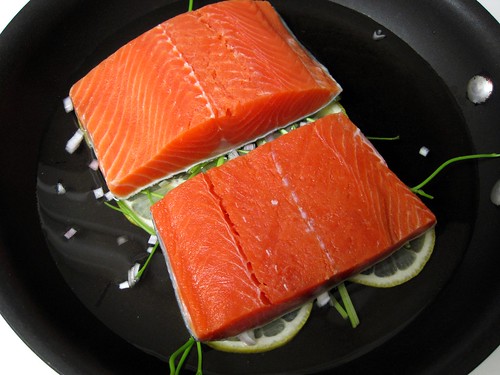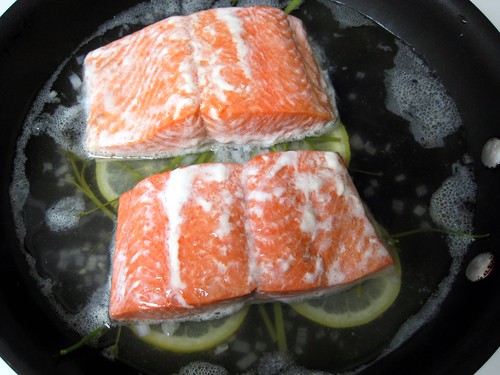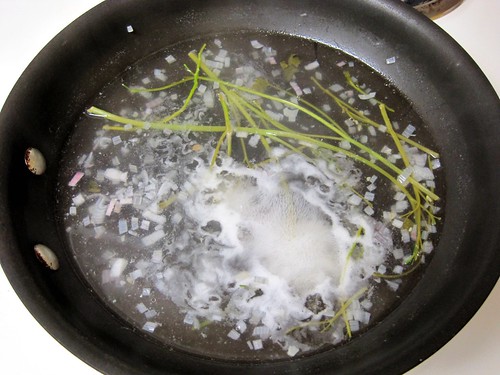Ahem.
Let's begin at the beginning, and the beginning is where we gather up the necessary ingredients:
- 1 lemon
- 2 tablespoons of freshly chopped parsley leaves, stems saved
- 2 tablespoons of freshly chopped tarragon leaves, stems saved
- 1 small shallot, minced
- 1/2 cup dry white wine
- 1/2 cup water
- 2 single-portion-sized salmon fillets (hopefully of about even thickness so they cook at the same time)
- 1 tablespoon of capers, rinsed and roughly chopped
- 1 tablespoon of honey
- 2 tablespoons of extra virgin olive oil
- salt and pepper to taste

Place the salmon fillets on top of the pile (he's king of the world!) and add the wine and water to the pan.

Bring the water and wine to a simmer over high heat, then reduce the temperature to low, cover the pan, and let that cook until it looks cooked. This should tale about 9-14 minutes, depending on how thick your fillets are.

(And now I'll be like the Beastie Boys and drop some science on your ass! The white stuff that forms all over your salmon--and lobster, for that matter--is simply coagulated albumin. And what is albumin, you ask? Well, albumin is a water-soluble protein that denatures under heat. Which basically means that it coagulates. Just like an egg white! And thus concludes today's science/Beastie Boys lesson.)
When the salmon is cooked, remove it (with the lemon slices) to a paper towel-lined plate and tent it loosely with aluminum foil.
Return the pan (with the remaining liquid) to high heat and simmer that down until it has thickened slightly and reduced to about 2 tablespoons.

Guess what? IT'S LATER. So mix the rest of your shallots, chopped herbs, capers, honey, and olive oil in a bowl.

When the poaching liquid has reduced, strain it into the bowl with all that stuff I just mentioned and whisk it all up to combine. Add salt and pepper until you're happy with it.
Then plate your salmon! (If your fillets are NOT skinless, an easy way to remove the skin before serving is by sliding a thin, wide spatula (exactly like a fish spatula) between the flesh of the fillet and the skin until it's separated.)
Sprinkle a little salt and pepper over each fillet and top it with a little of the sauce you just made. Add a wedge of lemon on the side for (lovin' touchin' and) squeezin' purposes.

Here, I put my fish right on top of some Israeli couscous, but you can put your fish on top (or on the side) of anything you like. That's what's so great about cooking! If you don't like it, don't do it!

De-naturing stuff is SO much fun!!
ReplyDeletei should also note that unlike traditional poached salmon recipes, mine isn't actually submerged in liquid. helps it keep its flavor better that way.
ReplyDeleteThis looks so good. I'm going to try it, even though cooking fish scares me (no, I don't know why).
ReplyDelete